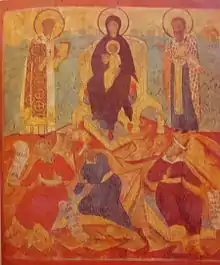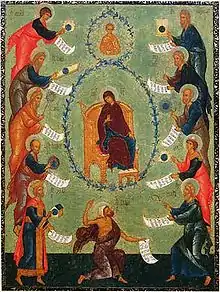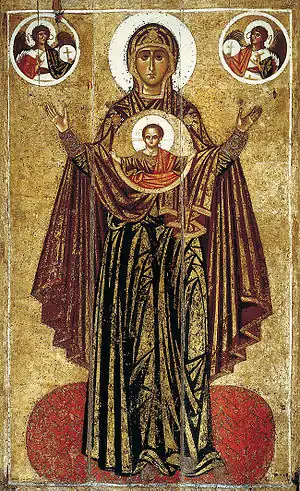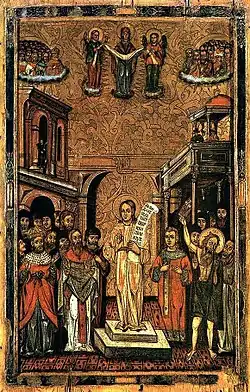Akathist
An Akathist Hymn (Greek: Ἀκάθιστος Ὕμνος, "unseated hymn") is a type of hymn usually recited by Eastern Orthodox or Eastern Catholic Christians, dedicated to a saint, holy event, or one of the persons of the Holy Trinity. The name derives from the fact that during the chanting of the hymn, or sometimes the whole service, the congregation is expected to remain standing in reverence, without sitting down (ἀ-, a-, "without, not" and κάθισις, káthisis, "sitting"), except for the aged or infirm. During Eastern Catholic and Orthodox Christian religious services in general, sitting, standing, bowing and the making of prostrations are set by an intricate set of rules, as well as individual discretion. Only during readings of the Gospel and the singing of Akathists is standing considered mandatory for all.
| Part of a series on the |
| Eastern Orthodox Church |
|---|
| Overview |
History
The Akathist is also known by the first three words of its prooimion (preamble), Te upermacho stratego (Τῇ ὑπερμάχῳ στρατηγῷ, "To you, invincible champion") addressed to Holy Mary (Panagia Theotokos, "The all-holy birth-giver of God").
The akathist par excellence is the one written during the seventh century for the feast of Annunciation of the Theotokos (25 March). This kontakion was traditionally attributed to Romanos the Melodist since kontakia of Romanos dominated the classical repertoire 80 kontakia sung during the cathedral rite of the Hagia Sophia, though recent scholarship rejects this authorship like in case of many other kontakia of the core repertoire. The exceptional case of the Akathist is that the Greek original consists of 24 oikoi, each one beginning with the next letter of the alphabet.[1] Due to the excessive length the kontakion became truncated like the others, but even the earliest chant books with musical notation (the Tipografsky Ustav, for instance) have the complete text of all 24 oikoi written out, but the last 23 oikoi without musical notation.[2]
Since the 14th century the Akathist moved from the menaion to the moveable cycle of the triodion, and the custom established that the whole hymn was sung in four sections throughout Lent. As such it became part of the service of the Salutations to the Theotokos (used in the Byzantine tradition during Great Lent).
Another particular characteristic feature of the Akathist is the extraordinary length of the refrain or ephymnion which conists of a great number of verses beginning with χαῖρε (“Rejoice”) which are called in Greek Chairetismoi (Χαιρετισμοί, "Rejoicings") or in Arabic Madayeh, respectively; in the Slavic tradition it is known as Akafist. The chairetismoi are only repeated in every second oikos, and from a musical point of view the ephymnion consists just of a short musical phrase, either about the last χαῖρε verse or about allelouia.
The writing of akathists (occasionally spelled acathist) developed within the Slavic traditions as a genre of its own as part of the general composition of an akolouthia, although not all compositions are widely known nor translated beyond the original language. Reader Isaac E. Lambertsen has done a large amount of translation work, including many different akathists. Most of the newer akathists are pastiche, that is, a generic form imitating the original 6th-century akathist to the Theotokos into which a particular saint's name is inserted. In the Greek, Arabic, and Russian Old Rite traditions, the only akathist permitted in formal liturgical use is the original akathist.
Legends about the origin

Apart from its usual dedication to the menaion and the early custom to celebrate kontakia during the Pannychis (festive night vigil celebrated at the Blachernae chapel),[3] the Akathist had also the political function to celebrate military victories or to ask during wars for divine protection intermediated by prayers of the Theotokos. This function is reflected within the synaxarion.
According to the synaxary the origin of the feast is assigned by the Synaxarion to the year 626, when Constantinople, in the reign of Heraclius, was attacked by the Persians and Avars but saved through the intervention of the Most Holy Theotokos. A sudden hurricane dispersed the fleet of the enemy, casting the vessels on the shore near the Great church of the Theotokos at Blachernae, a quarter of Constantinople inside the Golden Horn. The people spent the whole night, says the account, thanking her for the unexpected deliverance. "From that time, therefore, the Church, in memory of so great and so divine a miracle, desired this day to be a feast in honour of the Mother of God ... and called it Acathistus" (Synaxarion). This origin is disputed by Sophocles (Greek Lexicon of the Roman and Byzantine Periods, s. v.) on the ground that the hymn could not have been composed in one day, while on the other hand its twenty-four oikoi contain no allusion to such an event and therefore could scarcely have been originally composed to commemorate it. Perhaps the kontakion, which might seem to be allusive, was originally composed for the celebration on the night of the victory. However the feast may have originated, the Synaxarion commemorates two other victories, under Leo III the Isaurian, and Constantine Pogonatus, similarly ascribed to the intervention of the Theotokos.
No certain ascription of its authorship can be made. It has been attributed to Patriarch Sergius I of Constantinople, whose pious activities the Synaxarion commemorates in great detail. Quercius (P.G., XCII, 1333 sqq.) assigns it to George Pisida, deacon, archivist, and sacristan of Hagia Sophia whose poems find an echo both in style and in theme in the Akathist; the elegance, antithetic and balanced style, the vividness of the narrative, the flowers of poetic imagery being all very suggestive of his work. His position as sacristan would naturally suggest such a tribute to the Theotokos, as the hymn only gives more elaborately the sentiments condensed into two epigrams of Pisida found in her church at Blachernae. Quercius also argues that words, phrases, and sentences of the hymn are to be found in the poetry of Pisida. Leclercq (in Cabrol, Dictionnaire d’archéologie chrétienne et de liturgie, s.v. "Acathistus") finds nothing absolutely demonstrative in such a comparison and offers a suggestion which may possibly help to a solution of the problem.
Structure
When an akathist is chanted by itself, the Usual beginning, a series of prayers which include the Trisagion (thrice-holy) is often said as a prelude to the akathist hymn. The akathist may also be included as a part of another service, such as Matins or a Molieben.
The hymn itself is divided into thirteen parts, each of which is composed of a kontakion and an oikos (Greek: οίκος, house, possibly derived from Syriac terminology). The kontakion usually ends with the exclamation: Alleluia, which is repeated by a choir in full settings or chanted by the reader in simple settings. Within the latter part of the oikos comes an anaphoric entreaty, such as Come or Rejoice.
For example, the Akathist to the Theotokos:
- Queen of the Heavenly Host, Defender of our souls, we thy servants offer to thee songs of victory and thanksgiving, for thou, O Mother of God, hast delivered us from dangers. But as thou hast invincible power, free us from conflicts of all kinds that we may cry to thee:
- Rejoice, unwedded Bride!
- An Archangel was sent from Heaven to say to the Mother of God: Rejoice! And seeing Thee, O Lord, taking bodily form, he was amazed and with his bodiless voice he stood crying to her such things as these:
- Rejoice, thou through whom joy will flash forth!
- Rejoice, thou through whom the curse will cease!
- Rejoice, revival of fallen Adam!
- Rejoice, redemption of the tears of Eve!
- Rejoice, height hard to climb for human thoughts!
- Rejoice, depth hard to contemplate even for the eyes of Angels!
- Rejoice, thou who art the King's throne!
- Rejoice, thou who bearest Him Who bears all!
- Rejoice, star that causest the Sun to appear!
- Rejoice, womb of the divine incarnation!
- Rejoice, thou through whom creation becomes new!
- Rejoice, thou through whom the Creator becomes a babe!
- Rejoice, unwedded bride!
The thirteenth kontakion (which, unlike the preceding twelve, does not have a corresponding oikos) is usually followed by the repetition of the first oikos and kontakion. After the thirteen kontakia and oikoi, additional prayers are added, such as a troparion and another kontakion. The final kontakion is the famous "Tēi Hypermáchōi Stratēgōi" ("Unto the Defender General"), a hymn addressing Mary as the savior of Constantinople in the 626 siege:
Various ways of celebration

When the word akathist is used alone, it most commonly refers to the original hymn by this name, the 6th century Akathist to the Theotokos. This hymn is often split into four parts and sung at the "Salutations to the Theotokos" service on the first four Friday evenings in Great Lent; the entire Akathist is then sung on the fifth Friday evening. Traditionally it is included in the Orthros (Matins) of the Fifth Saturday of Great Lent, which for this reason is known as the "Saturday of the Akathist". In monasteries of Athonite tradition, the whole Akathist is usually inserted nightly at Compline.
The four sections into which the Akathist is divided correspond to the themes of the Annunciation, Nativity, Christ, and the Theotokos herself.
The hymn itself forms an alphabetical acrostic—that is, each oikos begins with a letter of the Greek alphabet, in order—and it consists of twelve long and twelve short oikoi. Each of the long oikoi include a seven-line stanza followed by six couplets employing rhyme, assonance and alliteration, beginning with the greeting Chaíre and ending with the refrain, "Rejoice, Bride without bridegroom!" (also translated as "Rejoice, thou Bride unwedded!") In the short oikoi, the seven-line stanza is followed by the refrain, Alleluia.
The Salutations to the Theotokos service, often known by its Greek name, the Χαιρετισμοί/Chairetismoí (from the Χαίρε/Chaíre! so often used in the hymn), consists of Compline with the Akathist hymn inserted. It is known in Arabic as the Madayeh.
Icons
There are also several icons of the Theotokos which are known by the title of "Akathist":
Hilandar
The Icon of the Theotokos "Of the Akathist" is on the iconostasis of Hilandar Monastery on Mount Athos. In 1837 a fire occurred at this monastery, and the monks were chanting the Akathist Hymn in front of this icon. Though the fire caused great destruction around it the icon itself remained untouched by the flames.
The feast day of the Icon of the Theotokos "Akathist-Hilandar" is celebrated on January 12 (for those churches which follow the Julian Calendar January 12 falls on January 25 of the modern Gregorian Calendar).
Zographou
A similar icon is venerated in the Monastery of Zographou, also on Mount Athos. The feast day of the Icon of the Theotokos "Akathist-Zographou" is celebrated on October 10 (October 23).
References
- See the majuscules in ET-MSsc Gr. 925, ff.80r-87r.
- For the earliest translation into Old Church Slavonic within the territory of the Kievan Rus, see Moscow, State Tretyakov Gallery, Ms. K-5349, ff.58v-64r (about 1100). The second folio (between 58 and 59) with the continuation of the notated prooimion and the text of the first three oikoi is missing.
- Alexander Lingas (1995).
Sources
- "Sinai, Saint Catherine's Monastery, Ms. Gr. 925". Kontakarion organised as a menaion, triodion (at least in part), and pentekostarion (10th century).
- "Saint-Petersburg, Rossiyskaya natsional'naya biblioteka, Ms. Q.п.I.32". Nižegorodsky Kondakar' of the Blagoveščensky [Annunciation] Monastery, introduced, described and transcribed by Tatiana Shvets (about 1200).
- "Moscow, Russian State Library (Российская государственная библиотека), fond 304 Ms. 23". Troitsky Kondakar’ of the Trinity Lavra of Saint Sergius (about 1200).
- "Moscow, Gosudarstvenniy istoričesky muzey (Государственный исторический музей), Ms. Sin. 777". Sinodal’ny Kondakar’ (13th century).
- "Sinai, Saint Catherine's Monastery, Ms. Gr. 1280". Psaltikon (Prokeimena, Allelouiaria, Hypakoai, Anti-cherouvikon for the Liturgy of Presanctified Gifts) and Kontakarion (menaion with integrated movable cycle) with Middle Byzantine round notation written in a monastic context (about 1300).
- "Sinai, Saint Catherine's Monastery, Ms. Gr. 1314". Psaltikon-Kontakarion (prokeimena, allelouiaria, kontakarion with integrated hypakoai, hypakoai anastasima, rest of the complete Akathistos hymnus, kontakia anastasima, appendix with refrains of the allelouiaria in oktoechos order) written by monk Neophyte (mid 14th century).
- "Sinai, Saint Catherine's Monastery, Ms. Gr. 1262". Oikematation written at the scriptorium of the Esphigmenou Monastery on Mount Athos (1437).
Editions
- Papagiannis, Gregorios (2006). Ακάθιστος Ύμνος. Άγνωστες πτυχές ενός πολύ γνωστού κειμένου. Κριτικές και μετρικές παρατηρήσεις, σχολιασμένη βιβλιογραφία. Thessaloniki.
- Uspenskiy, Boris Aleksandrovič, ed. (2006). Типографский Устав: Устав с кондакарем конца XI — начала XII века [Tipografsky Ustav: Ustav with Kondakar' end 11th-beginning 12th c. (vol. 1: facsimile, vol. 2: edition of the texts, vol. 3: monographic essays)]. Памятники славяно-русской письменности. Новая серия. 1–3. Moscow: Языки славянских культур. ISBN 978-5-9551-0131-6.
- Wellesz, Egon, ed. (1957). The Akathistos Hymn. Monumenta musicae Byzantinae. Transcripta. 9. Copenhagen: Munksgaard.
Studies
- Churkin, Aleksandr (2007). “Русский акафист середины XIX – начала XX века, как жанр массовой литературы. Доклад [The Russian Akathist in the middle of 19th – beginning 20th century as a mass literature genre. Report]”. In Bolsheva, A. O. (ed.). Материалы XXXVI Международной филологической конференции 12 – 17 марта 2007 г. St. Petersburg. pp. 23-33.
- Gove, Antonina F. (1988). The Slavic Akathistos Hymn (Peter Lang: reprint ed.). Munich: Otto Sagner. doi:10.3726/b12731. ISBN 9783954792160.
- Lingas, Alexander (1995). "The Liturgical Place of the Kontakion in Constantinople". In Akentiev, Constantin C. (ed.). Liturgy, Architecture and Art of the Byzantine World: Papers of the XVIII International Byzantine Congress (Moscow, 8–15 August 1991) and Other Essays Dedicated to the Memory of Fr. John Meyendorff. Byzantino Rossica. 1. St. Petersburg. pp. 50–57.
External links
- Some material for this article taken from Akathist, an OrthodoxWiki article.
- Akathist Hymn
- The Akathist Hymn and background
- Acathistus article from The Catholic Encyclopedia
- Saturday of the Akathist Orthodox icon and synaxarion
- Icon of the Theotokos of the Akathist-Hilandar
- Icon of the Theotokos of the Akathist-Zographou
- Article with akathists to different saints

